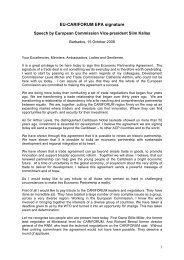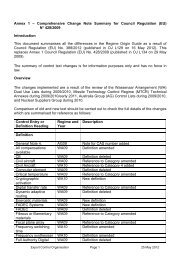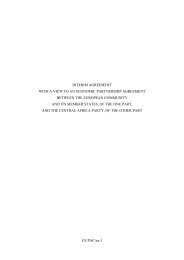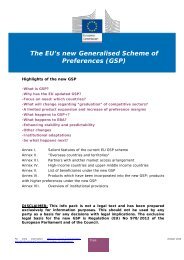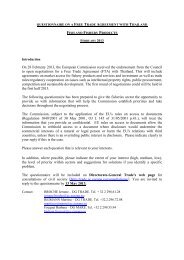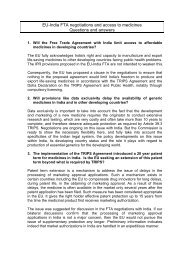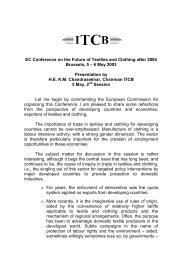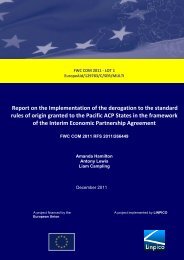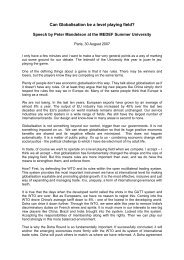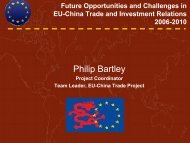Agricultural Commodity Chains, Dependence and Poverty
Agricultural Commodity Chains, Dependence and Poverty
Agricultural Commodity Chains, Dependence and Poverty
You also want an ePaper? Increase the reach of your titles
YUMPU automatically turns print PDFs into web optimized ePapers that Google loves.
COMMISSION OF THE EUROPEAN COMMUNITIESBrussels, 12.02.2004COMMUNICATION FROM THE COMMISSION TO THE COUNCIL AND THEEUROPEAN PARLIAMENT<strong>Agricultural</strong> <strong>Commodity</strong> <strong>Chains</strong>, <strong>Dependence</strong> <strong>and</strong> <strong>Poverty</strong>- A proposal for an EU Action PlanCONTENTS1. Why an EU Action Plan in support of <strong>Agricultural</strong> commodities in developingcountries? ..................................................................................................................... 52. Addressing commodity chains <strong>and</strong> dependence as a priority ...................................... 72.1. Policy Response: Developing commodity strategies, at national <strong>and</strong> internationallevel.............................................................................................................................. 82.2. Proposed EU actions .................................................................................................... 92.2.1. Supporting the development of CDDC commodity strategies..................................... 92.2.2. Pursuing reform of International <strong>Commodity</strong> Bodies <strong>and</strong> their strategies .................. 93. Coping with long term price decline.......................................................................... 103.1. Policy response: Raising competitiveness of commodities <strong>and</strong> the economy ........... 103.1.1. Improving capacity <strong>and</strong> support services at producer level....................................... 103.1.2. Ensuring essential infrastructure for commodity producing areas............................. 113.1.3. Pursuing policy reforms at the macro level................................................................ 113.1.4. Developing <strong>and</strong> exploiting regional integration......................................................... 123.2. Proposed EU actions .................................................................................................. 123.2.1. Support the implementation of commodity chain strategies...................................... 123.2.2. Development of regional support services................................................................. 123.2.3. Support to Economic Partnership Agreements with the ACP ................................... 121
4. Managing commodity risks <strong>and</strong> accessing finance.................................................... 134.1. Policy Response: Developing institutions <strong>and</strong> instruments ....................................... 134.2. Proposed EU actions .................................................................................................. 144.2.1. Facilitating producer access to commodity risk insurance <strong>and</strong> trade finance............ 144.2.2. Developing shock management tools for the macro-level......................................... 154.2.3. Improving access to the EU Flex compensatory instrument...................................... 155. Diversifying around traditional commodities ............................................................ 155.1. Policy Response – increasing government capacity to support diversification ......... 165.2. Proposed EU action.................................................................................................... 175.2.1. Informing government choices .................................................................................. 175.2.2. Supporting rural growth ............................................................................................. 175.2.3. Strengthening private sector support.......................................................................... 186. Successfully integrating with the international trading system.................................. 186.1. Policy Response: Maximising opportunities for CDDCs in the multilateral tradingsystem......................................................................................................................... 196.2. Proposed EU actions .................................................................................................. 206.2.1. Securing a development friendly outcome in the Doha Development Agenda......... 206.2.2. Monitoring the external impact of agricultural policies............................................. 206.2.3. Maximising access to the EU market for CDDCs ..................................................... 216.2.4. Supporting CDDCs efforts to valorise their market access ....................................... 217. Enhancing Sustainable Corporate Practices <strong>and</strong> Investments in CDDCs.................. 217.1. Policy response: Fostering corporate responsibility for sustainable commodityproduction .................................................................................................................. 227.2. Proposed EU actions .................................................................................................. 237.2.1. Promoting Corporate Social Responsibility internationally ...................................... 237.2.2. Enabling CDDCs to benefit from CSR ...................................................................... 247.2.3. Promoting Competition.............................................................................................. 248. Next steps................................................................................................................... 242
1. WHY AN EU ACTION PLAN IN SUPPORT OF AGRICULTURAL COMMODITIES INDEVELOPING COUNTRIES?<strong>Commodity</strong> dependence is back on the international agenda. The dramatic recent price fallshave incited the international community to scrutinize the issue <strong>and</strong> make a series of generalcommitments to take action 1 . Most recently, several commodity dependent developingcountries (CDDCs 2 ) have focussed the attention of the WTO on their situation, arguing forspecial attention to be paid to them 3 .Internationally traded agricultural commodities are crucial to the employment <strong>and</strong> income formillions of people in developing countries, as well as a major source of revenue <strong>and</strong> foreignexchange of many developing states. For many sub-national regions within developingcountries, too, commodities are the engine for economic development. The producers of theseproducts live an unpredictable existence, however, because the prices for a wide range ofcommodities are very volatile, <strong>and</strong> in addition follow a declining long-term trend. Between1970 <strong>and</strong> 2000, prices for some of the main agricultural exports of developing countries, suchas sugar, cotton, cocoa <strong>and</strong> coffee, fell by 30 to 60 percent (constant dollars).The declining <strong>and</strong> volatile prices lead directly to lower levels of human development bynegatively affecting farm incomes, agricultural wages, employment <strong>and</strong> the health of the ruralpopulation. They are particularly damaging for the efforts to reduce poverty in CDDCs, wherea significant part of the population <strong>and</strong> the economy depend on these products. There, theprice patterns also lead to macroeconomic imbalances: curtailing export earnings, debt servicecapacity, imports, credit availability, government revenues <strong>and</strong> provisions of basic servicessuch as health <strong>and</strong> education.In about 50 countries, three or fewer primary commodity exports constitute the bulk of exportrevenue. These countries are located mainly in Sub-Saharan Africa, but also in the Caribbean<strong>and</strong> Central America (see Annex). Many are LDCs, l<strong>and</strong>locked or small isl<strong>and</strong> states. ManyCDDCs are caught in a trap of declining income <strong>and</strong> investment, stagnating competitiveness,persistent poverty <strong>and</strong> dependence. Their commodity sectors have difficulties in adapting toincreasingly harsh international competition <strong>and</strong> changes in the international marketenvironment, but these countries have few resources to counter the situation.In the view of the Commission, traditional commodity sectors still have a role as a key sourceof employment, income, export earnings <strong>and</strong> poverty reduction in CDDCs. But measures areneeded to support them. Without such action, these sectors may fail in many countries, withmajor socio-economic <strong>and</strong> political consequences.123E.g. the Third UN Conference on the Least Developed Countries in Brussels 2001, The DohaDeclaration of November 2001; The Finance for Development Conference in Monterrey 2002; TheWorld Summit for Sustainable Development in Johannesburg 2002; The United Nations GeneralAssembly 2002“CDDC” is used for convenience throughout this document as an abbreviation. It refers to countries thatare particularly exposed to developments such as price variability in international agriculturalcommodity markets <strong>and</strong> thus share certain development challenges. It should not be taken to suggestthat a specific definition exists, or indeed should exist.Communication from Kenya, Ug<strong>and</strong>a <strong>and</strong> Tanzania.(WTO WT/COMTD/W/113 of 19 May 2003); <strong>and</strong>’Sectoral initiative on cotton’, Presented to WTO by Chad, Mali, Benin <strong>and</strong> Burkina Faso, WT/MIN(03)/W/2 in connection with WT/GC/W/516TN/AG/GEN/43
This Communication follows directly from an EC staff working document on agriculturalcommodity trade, dependence <strong>and</strong> poverty (SEC (2003) 908). That document exploredchallenges facing developing countries depending on agricultural commodities, as well aspossible strategies in these countries. The present paper proposes an EU Action plan insupport of such CDDCs <strong>and</strong> their producers. The overall objectives of the proposed actionsare to:• improve incomes for producers, from traditional or other commodities; <strong>and</strong>• reduce income vulnerability, at both producer <strong>and</strong> macro level.The paper focuses on agricultural (rather that mineral) commodities that are traded <strong>and</strong>marketed internationally. This is principally because agricultural commodities have a moredirect poverty link than mineral commodities due to the very large involvement ofsmallholders <strong>and</strong> labourers in production. Timber is not covered by the present paper since theCommission already has a specific strategy, budget line <strong>and</strong> large ongoing programmes forthis sector <strong>and</strong> in addition is pursuing an action plan to combat illegal logging 4 .This Communication complements other recent Communications, in particular Com (2002)429 ”Fighting Rural <strong>Poverty</strong>”; Com (2002) 513 “Trade <strong>and</strong> Development - AssistingDeveloping Countries to Benefit from Trade” <strong>and</strong> the Communication of 26th November2003 “Reviving the DDA Negotiations – an EU perspective”. It is accompanied by theCommission ‘Proposal for an EU-Africa partnership in support of cotton sector development’which is being launched simultaneously <strong>and</strong> represents a specific application of the policies<strong>and</strong> measures outlined in this Communication for cotton dependent developing countries.The paper proposes policy priorities in response to six major challenges facing CDDCs:Addressing commodity dependence as a priority at national <strong>and</strong> international level; copingwith price decline; managing commodity risks <strong>and</strong> accessing finance; diversifying aroundtraditional commodities; successfully integrating with the international trading system; <strong>and</strong>enhancing sustainable corporate practices <strong>and</strong> investments in CDDCs.It is vital to the success of this Action Plan that a common approach is agreed within the EU,so that efforts by the Community <strong>and</strong> by Member States reinforce each other. There must bebroad support within the EU if progress is to be made in the areas covered in this paper,including where Member States act in their own right as bilateral aid donors or ininternational bodies such as the World Bank, IMF <strong>and</strong> UN; <strong>and</strong> when the Commission acts forthe Community within the trade arena <strong>and</strong> elsewhere. The Commission looks forward to astimulating dialogue with Member States in order to clarify priorities <strong>and</strong> roles to secure arapid <strong>and</strong> effective implementation of this action plan. A matrix in annex provides a basis fordiscussion.2. ADDRESSING COMMODITY CHAINS AND DEPENDENCE AS A PRIORITYThe ab<strong>and</strong>onment of international intervention policies at the end of the 1980s <strong>and</strong> thecommodity market reforms of the 1990s in the developing countries left the commoditysectors, <strong>and</strong> in particular small producers, largely to themselves in their struggle with thedem<strong>and</strong>s of the market. Despite the importance of the commodity sectors for poverty4See Com (2003) 251 on an EU Action Plan for Forest Law Enforcement, Governance, <strong>and</strong> Trade(FLEGT) of 21 May 20034
eduction <strong>and</strong> the difficulties they experience, national development strategies have largelyleft these issues aside. At the international level, International <strong>Commodity</strong> Bodies (ICBs) arefaced with the task of reformulating their objectives for the new context.2.1. Policy Response: Developing commodity strategies, at national <strong>and</strong>international levelNational level: In the view of the Commission, CDDC governments need to developstrategies to deal with the decline of their commodity sectors <strong>and</strong> the changing internationalcommodity markets. As part of poverty reduction efforts, these should be embedded innational development strategies such as <strong>Poverty</strong> Reduction Strategies. To address allconstraints simultaneously it may be necessary to reflect commodity chain priorities insectoral strategies (e.g. agriculture, transport) or multisectoral ones (e.g. rural development).This will allow the Government to make important trade-offs such as those between supportto food crops <strong>and</strong> cash crops; existing <strong>and</strong> alternative production; or the volume of investmentin traditional commodity-producing areas with relatively higher growth <strong>and</strong> employmentpotential versus more resource-poor or remote areas.The strategy should be based on a detailed chain analysis, covering the sector’s strengths <strong>and</strong>weaknesses, as well as threats <strong>and</strong> opportunities. This is important in order to be able toprioritise solutions. The strategy should identify measures to improve the competitiveness <strong>and</strong>returns to labour for traditional commodities <strong>and</strong> reduce the vulnerability of producers.Environmental issues will need specific attention, for sustainability, health <strong>and</strong>competitiveness reasons <strong>and</strong> with a view to addressing global environmental challengesrelated to agriculture, such as climate change, desertification, soil degradation, biodiversityloss <strong>and</strong> water pollution in a coherent manner. The strategy may include measures to supportalternative income opportunities for producers who are unlikely to remain competitive in theircurrent activity. It could also look at ways to reduce vulnerability to revenue shocks at macrolevel. The strategies need to take into account regional constraints <strong>and</strong> opportunities, whileaiming at greater regional integration <strong>and</strong> economies of scale. A key role of a commoditychain strategy is to define the respective roles of all actors in the chain, <strong>and</strong> look for synergies<strong>and</strong> partnerships. Therefore, multi-stakeholder participation during the formulation <strong>and</strong>implementation of the commodity strategy is crucial. The strategies must be flexible <strong>and</strong>regularly reviewed so as to respond to emerging challenges. Whilst implementing the strategymay not necessarily entail large financial investment by government, it will require stronggovernmental, institutional <strong>and</strong> human capacities to address obstacles <strong>and</strong> bottlenecks throughregulatory measures, etc. These may be more scarce than financial resources <strong>and</strong> theiropportunity cost needs to be factored in.International level: The international community, for its part, needs a vision on thedevelopment of the individual commodity sectors as a whole. It needs a framework foranalysing short <strong>and</strong> long term price developments; for helping to improve market functioning(for example through market information); <strong>and</strong> for addressing developments relating notablyto trade rules, traceability, sustainability, <strong>and</strong> quality requirements. This could be achievedlargely through a strengthening of the individual commodity strategies of the International<strong>Commodity</strong> Bodies (ICBs). In particular, it is the view of the Commission that the ICBsshould work more forcefully towards sustainable development objectives, including pro-poordevelopment. This should incorporate a commodity chain perspective, as also urged by theCommon Fund for Commodities in 2003. With better objectives, strategies, <strong>and</strong> stakeholderparticipation, the ICBs should be able to draw more effectively on, <strong>and</strong> influence, the effortsof other international actors working on cross-cutting commodity initiatives. By raising their5
level of ambition <strong>and</strong> improving their effectiveness the ICBs should be able to elicit renewedsupport from members.2.2. Proposed EU actions2.2.1. Supporting the development of CDDC commodity strategiesThe European Commission <strong>and</strong> Member States should support CDDCs in designingcommodity strategies <strong>and</strong> incorporating them into national development strategies. Suchsupport should include for example analysis of the sustainability, poverty implications <strong>and</strong>needs of commodity sectors; building of the human <strong>and</strong> institutional capacity needed toensure flexible <strong>and</strong> effective strategies; <strong>and</strong> support to multi-stakeholder participation. As afirst step, the EU should engage, within its regular collaboration structures, in a dialogue withcommodity dependent countries interested in cooperation to modernise or diversify theircommodity sectors.2.2.2. Pursuing reform of International <strong>Commodity</strong> Bodies <strong>and</strong> their strategiesWith reference to the Helsinki principles 5 agreed among Commission <strong>and</strong> Member States, <strong>and</strong>with a view to enhancing the performance of the ICB’s, the EU should engage to pursue theirreform:With respect to objectives <strong>and</strong> functions, the Commission considers that ICBs shouldbecome more oriented towards sustainable development, incorporating a clear focus onenvironmental <strong>and</strong> socio-economic sustainability into their current focus on marketfunctioning. The ICBs should become more responsive to stakeholders in both producing <strong>and</strong>consuming countries <strong>and</strong> respond to the current challenges of commodity markets. Inparticular, they should seek to advocate the sectors’ common interests (e.g. qualityupgrading), enhance transparency <strong>and</strong> a competitive market environment, stimulate genericdem<strong>and</strong> for the given commodity <strong>and</strong> facilitate <strong>and</strong> monitor projects that are of particularinterest to CDDCs. Synergies with national commodity strategies should be sought wherethey exist.With regard to justification <strong>and</strong> membership, an ICB should be supported by enoughmembers <strong>and</strong> stakeholders to justify a separate intergovernmental institution. An ICB does notnecessarily need an international commodity agreement, as long as it has an agreed m<strong>and</strong>ate(see the ICB on cotton). The EU should re-evaluate its membership in ICBs largely on thebasis of an appreciation of their contribution to EU sustainable development objectives <strong>and</strong>should consider withdrawing from ICB’s with low relevance, continuous poor performance orvery small size. Furthermore, in order to enhance visibility <strong>and</strong> impact, <strong>and</strong> reduce costs ofadministration, the Commission proposes to merge ICB’s covering related commodities: e.g.coffee <strong>and</strong> cocoa; jute, bamboo <strong>and</strong> rubber; FAO-hides, skins <strong>and</strong> meat, etc.5The Helsinki principles were agreed by the Council Group on Commodities when it met in an informalmeeting in Helsinki in 1999. Coreper took note of the conclusions of the meeting which state that:direct market interventions should be avoided; the positive experience of the international study groupsshould be reflected in the future co-operation; however, future forms of co-operation should be decidedon a case by case basis; there should be a minimum share of production <strong>and</strong> consumption presented toguarantee the effectiveness of the intergovernmental co-operation; the private sector should be given amore important role within the framework of co-operation; the structures <strong>and</strong> decision makingprocedures (including excessive administrative practices <strong>and</strong> requirements) should be streamlined.6
of situation <strong>and</strong> organisation of the targeted producers. A regional approach for most of theseservices is desirable for reasons of economies of scale.The majority of farmers, those producing for the mainstream market, should invest primarilyin the reduction of the average costs of production/marketing <strong>and</strong>/or in the pursuit of qualitypremiums. Farmers whose level of organisation <strong>and</strong> surrounding regulatory framework allowfor this can supply part of their produce to highly integrated speciality markets (geographicalorigins, organic, fair trade, etc.). This requires continuous quality improvement, ways toconnect with new markets <strong>and</strong>, for organics, the enacting of adequate legislation. Farmersable to cope with sophisticated requirements regarding quality, safety, production processes,delivery dates etc. could tap into the market (e.g. international retailers) for a diversified rangeof products, on the basis of adequate capacity building. For all types of farmers it is essentialto strengthen <strong>and</strong> upgrade farmer organisations, their commodity branch organisations, tradeassociations <strong>and</strong> regional networks. This will facilitate contacts with buyers; access to thespecific services needed by these different actors; <strong>and</strong> will enable grouping supply into largervolumes for the market.3.1.2. Ensuring essential infrastructure for commodity producing areasPublic infrastructure (roads, telecom, water <strong>and</strong> electricity) is vital for the competitiveness ofthe commodity sectors. This must be ensured by national governments <strong>and</strong> co-ordinated at theregional level. The availability of intraregional transport systems <strong>and</strong> an adequate network ofprimary <strong>and</strong> secondary roads to <strong>and</strong> within the commodity areas is crucial to reduce transportcosts, the main component of transaction costs. Reliable telecommunication systemsincluding mobile services are also vital for price information, expansion of sales networks <strong>and</strong>organisation of business transactions. While the state has a responsibility to provide some ofthis infrastructure, it also has a role to enforce legal frameworks which limit monopolisticsituations <strong>and</strong> rent seeking. 63.1.3. Pursuing policy reforms at the macro levelEffective liberalisation requires a new role for Governments - facilitating, enabling, regulating<strong>and</strong> monitoring of private sector operations. The adoption <strong>and</strong> enforcement of laws <strong>and</strong>regulations that reduce the cost <strong>and</strong> risk of doing business are crucial for promoting local <strong>and</strong>foreign investments. Governments need to lay down <strong>and</strong> enforce clear rules on contractualarrangements between market operators. They need to establish fair, transparent <strong>and</strong>predictable competitive conditions, using for example fiscal policies, competition policy,enforcement of minimum quality requirements for products <strong>and</strong> labour <strong>and</strong> environmentalrequirements for production. Measures are also necessary to reduce administrative costs <strong>and</strong>red tape relating to customs procedures, quality assessments <strong>and</strong> certification, leasing <strong>and</strong>purchase of l<strong>and</strong> etc. Addressing quality is of central importance, because if one exporter hasproblems to meet st<strong>and</strong>ards, it can harm the reputation of a whole country, <strong>and</strong> penalise alsoexporters who meet the requirements. Similarly, strengthening domestic environmentalrequirements may facilitate access to developed country markets while protecting the localenvironment <strong>and</strong> public health. Dialogue among key actors in the reform process will helpidentify obstacles to investment <strong>and</strong> optimise sequencing of reform measures.6See COM(2003)326 on the Reform of State-owned Enterprises in Developing Countries with focus onpublic utilities. The Need to Assess All the Options.8
3.1.4. Developing <strong>and</strong> exploiting regional integrationRegional integration offers unique opportunities to increase CDDC competitiveness,particularly for small countries. Inputs could be made cheaper following harmonisation ofproduct specifications, scaling up of trading volumes <strong>and</strong> number of suppliers. Similarly, itprovides additional opportunities for marketing outputs, including to processors <strong>and</strong> exportersin neighbouring markets, thus retaining value in the producing regions. Improving thebusiness conditions at the regional level will be crucial to making investment in areas likeprocessing more attractive. To take advantage of these potential benefits, efforts to removetariff <strong>and</strong> non-tariff barriers for products, services <strong>and</strong> people must be reinforced. But deeperintegration is also needed, in particular convergence of domestic policies <strong>and</strong> regulation,common regional transport networks <strong>and</strong> the adoption of harmonised or common st<strong>and</strong>ards.Market operations for commodities could be improved through regional commodityexchanges. So far in sub Saharan Africa these have not met with success at the national leveldue inter alia to the small size of the market. A regional commodity exchange can contributeto market transparency, reduced transaction costs <strong>and</strong> help to define better quality st<strong>and</strong>ards<strong>and</strong> improve the discipline in the market place, including contract enforcement.3.2. Proposed EU actions3.2.1. Support the implementation of commodity chain strategiesThe EU – Commission <strong>and</strong> Member States - should support the implementation of commoditystrategies, within the context of their country support <strong>and</strong> with the appropriate long termdevelopment instruments. As regards the EC, the existing funding from national <strong>and</strong> regionalindicative programmes under the European Development Fund (EDF) can be used. The midtermreview of the different ACP country strategies <strong>and</strong> programmed allocations will takeplace in 2004. It will be an important opportunity for the concerned countries, in partnershipwith the European Commission, to revisit the currently existing funding priorities <strong>and</strong> wherenecessary attach greater priority to commodity related themes such as agriculture <strong>and</strong> ruraldevelopment taking into account that the overall envelope for particularly performingcountries will be increased. Limited support can also potentially be extended even if ruraldevelopment/ agriculture are not retained as priority sectors in country programming.3.2.2. Development of regional support servicesThe EU (EC/MS) should support actions at regional level in support of commoditydevelopment: regional networks of farmer organisations, commodity branch organisation,trade associations; quality-enhancing services (certification, testing, market information);chain-related technology <strong>and</strong> market development research; co-ordinated provision ofinfrastructure such as transport networks; <strong>and</strong> investment promotion.3.2.3. Support to Economic Partnership Agreements with the ACPThe EC is fully committed to assisting CDDCs to pursue regional integration <strong>and</strong> isconvinced of the many potential benefits that this could bring. As regards the ACP, thenegotiations on Economic Partnership Agreements (EPAs) will be a main instrument to fostersuch integration. The negotiations will address issues relating to ACP trade performance bothwith the EU <strong>and</strong> between themselves, including commodity exports. Issues covered will rangefrom market access to trade related rules, including sanitary <strong>and</strong> phyto-sanitary st<strong>and</strong>ards,which have been identified as an important issue by the ACP. Interlinked development cooperationactivities will help the ACP to use this framework to support regional integration9
<strong>and</strong> trade including the development of commodity sectors. The Commission, in cooperationwith the ACP partners, will seek to ensure that the issue of commodity dependence is givenproper prominence throughout the EPA negotiations.Already, more than 30% of financial allocations have been set aside for ACP for trade <strong>and</strong>regional integration under the regional indicative programmes. This is complemented byadditional funding allocated under the national programmes <strong>and</strong> the all ACP programmes.Overall it is estimated that more than € 600 m will be allocated under EC programmes toregional integration <strong>and</strong> trade. The EC will pursue <strong>and</strong> strengthen these programmes wherenecessary within the context of the EPA process4. MANAGING COMMODITY RISKS AND ACCESSING FINANCELiberally operating markets for agricultural commodities tend to be characterised byalternating short periods (few years) of higher prices <strong>and</strong> longer periods of lower prices. Thereis high volatility within these cycles. Volatility creates uncertainty <strong>and</strong> reduces the willingness<strong>and</strong> capacity of farmers to invest. It may also create insecurity for other actors in the valuechain, increasing downward price pressures.Following liberalisation of agricultural markets in developing countries, including thedismantling of marketing boards, farmers became more exposed to market risks <strong>and</strong> the needto finance inputs themselves. Since banks are often reluctant to lend to the risky agriculturalsector, entrepreneurs may find themselves unable to upgrade production <strong>and</strong> technology, <strong>and</strong>to finance inputs, output marketing <strong>and</strong> processing.Governments are also affected by fluctuations in commodity prices which influence fiscalrevenues <strong>and</strong> reduce the ability to maintain basic service provision. They put further pressureon foreign exchange reserves <strong>and</strong> the currency, making debt servicing less sustainable <strong>and</strong>imports relatively more expensive.Compensatory finance has been an important tool to seek to buffer developing countries <strong>and</strong>producers against the worst effects of price <strong>and</strong> income volatility. Although these instrumentsprovided important resources, they have had problems relating in particular to disbursementrates, which have undermined their intended countercyclical effect. It now seems clear thatdifferent tools are needed to cushion impacts at producer <strong>and</strong> macro level.4.1. Policy Response: Developing institutions <strong>and</strong> instrumentsTo improve access to finance, there is a need to create more secure collateral for agriculturallending that would reduce the risk of non-repayment. Some new approaches are based on thecreation of liquid guarantees (as opposed to collateral on fixed assets – l<strong>and</strong>, machinery, etc.).These could include warehouse receipts 7 , longer-term contracts <strong>and</strong> risk managementinstruments. To accept lending against warehouse receipts, local banks need a trustworthy <strong>and</strong>affordable third party collateral manager; <strong>and</strong> a warehouse receipt regulation that protects therights of the warrant holder <strong>and</strong> limits the credit risk. Strengthening collateral managementservices can have important development impacts, as the techniques can be applied to a rangeof products, such as agricultural products, spare parts <strong>and</strong> fertilizers. Input credit could also bedeveloped by linking inputs to output markets. Another potential approach to channelling7Warehouse receipts represent certain quantities of commodities that the borrower has stored with a thirdparty10
capital to local producers is to encourage banks to lend against export contracts, in partnershipwith international <strong>and</strong> multilateral financial institutions. <strong>Agricultural</strong> micro-credits schemescould be additional in some areas.Market-based commodity risk insurance can offer producers <strong>and</strong> traders a possibility to hedgethe effects of price fluctuations or natural disasters within a cropping season. The <strong>Commodity</strong>Risk Management (CRM) initiative of the World Bank has started testing the feasibility ofput-options 8 in CDDCs, <strong>and</strong> is exp<strong>and</strong>ing to other instruments. To become operational,however, such tools need to be implemented on a scale sufficient to elicit interest fromfinancial providers. Therefore, exploring delivery channels to increase coverage <strong>and</strong> reduceadministration costs is critical. Other key actions are capacity building for potential buyers ofthese instruments (banks, cooperatives, etc) <strong>and</strong> encouraging the international providers toinvest in establishing relations with CDDCs. <strong>Commodity</strong> risk insurance can furthermorereduce the credit risk, if local banks are encouraged to integrate this service into theirportfolio to the commodity sector. It should, however, be noted that these hedging instrumentsare not designed to compensate farmers for long term price falls.Governments of CDDCs need ways to manage the macroeconomic vulnerability that resultsfrom their dependence – at the level of fiscal revenues <strong>and</strong> exchange rate stability/balance-ofpayments.Fiscal vulnerability can be reduced by broadening the tax base away fromcommodities, increasing the effectiveness of tax collection, <strong>and</strong> pursuing counter-cyclicalfiscal policies. Such reforms are long-term processes, however. Balance-of-payments effectsof price volatility are even more difficult to address.Most CDDCs will need access to insurance (hedging) tools to cushion impacts at macro level.Several tools can be envisaged that could potentially replace, at least partially, the existingmacro-level compensatory schemes of international donors. Against a premium, suchinsurance would guarantee a certain level of budget revenues <strong>and</strong> foreign exchange in case theprice of the export commodity drops below an insured level. Other risks, such as specificclimatic events affecting output, can also be hedged. Hedging schemes for export revenue canbe extended to cover basic imported commodities, e.g. oil, grains <strong>and</strong> agri-inputs.4.2. Proposed EU actions4.2.1. Facilitating producer access to commodity risk insurance <strong>and</strong> trade financeThe EU will jointly support the developing <strong>and</strong> piloting of a range of new insurance <strong>and</strong>finance instruments for the various operators in the commodity chain, including producers.Following encouraging results from pilot initiatives on <strong>Commodity</strong> Risk Management, thechallenge is now to scale them up to reach a level of effective dem<strong>and</strong> that would drawenduring attention of the international providers of these instruments. Trade finance could beintegrated into the CRM initiative.4.2.2. Developing shock management tools for the macro-levelThe EU will support piloting of the use of market based insurance tools at the macro-level, tocushion the effects of commodity shocks. This includes identifying which international8In a price risk transaction with put options, the buyer pays a premium to lock in a certain price (strikeprice) for a given date on an international commodity exchange. If the price on the commodityexchange on the agreed date is lower than the strike price, the insurance buyer receives a pay-out. If theprice is higher, the producer sells at the market price, but loses the premium11
egulatory framework will be needed for the application of these instruments. Theinternational community should also consider temporary co-financing of the premium linkedto this type of insurance, while abiding by related international rules. In relation to this, theEU should support CDDCs establish safety net programs to channel resources to thoseaffected by commodity shocks.The EU, together with the international community, should continue to explore alternativeinternational lending arrangements, where CDDCs have lower debt-servicing obligationswhen export revenues fall. Options include commodity-based loans, local currency loans,integrating commodity shock management into existing instruments of international financeinstitutions <strong>and</strong> synergies with grant-based compensatory finance.4.2.3. Improving access to the EU Flex compensatory instrumentWith the entry into force of the EU-ACP Cotonou Agreement a new instrument wasestablished to compensate countries for sudden falls in export earnings, the Flex. The Flexprovides additional budgetary resources to ACPs in order to safeguard macro-economic <strong>and</strong>sectoral reforms <strong>and</strong> policies that are at risk as a result of a fall in export revenue.Initial experiences with the Flex have shown that several countries that experienced importantlosses in export earnings were not eligible for compensation: The Commission intends topropose in May 2004 to the ACP-EC Council of Ministers the appropriate amendments toAnnex II of the Cotonou Agreement, so as to allow for applicability of the new conditionsalready for cases relating to 2003. The revision of the Cotonou Agreement will also be anopportunity to reconsider ways of supporting CDDCs. As the resources made available by theCommission for Flex are limited, the MS should consider complementing this mechanism bybudgetary support.CDDCs could consider allocating Flex resources to the implementation of nationalcommodity chain strategies. In areas where structural changes in global commodity marketshave made production permanently uncompetitive, CDDCs could also establish long termprograms aimed at assisting farmers in making the transition to other rural activities.5. DIVERSIFYING AROUND TRADITIONAL COMMODITIESCDDCs mostly export a small range of commodities without much value added. Thissituation creates vulnerability, at macro <strong>and</strong> producer level <strong>and</strong> indicates a foregoneopportunity to retain more value <strong>and</strong> thus income in producing countries. Diversification iscommonly seen as the remedy to both these problems, but developing <strong>and</strong> implementing adiversification strategy is complex.For example, smaller commodity producing countries are at a comparative disadvantage toenter into (secondary) processing of traditional commodities. The lack of domestic marketscoupled with high levels of perceived risk mean that few companies, domestic or foreign, arewilling to make the investments required. In the short term, other approaches are needed toadd value <strong>and</strong> increase margins for traditional commodities – as outlined in chapter 3.Most DCs also face serious challenges in diversifying into non-traditional commodities oractivities: a) lack of experience/knowledge in manufacturing <strong>and</strong> marketing non-traditionalcommodities in international markets; b) lack of access to <strong>and</strong> costs of financial services fornew industries; c) absence of public infrastructure; d) weak regulatory <strong>and</strong> legal frameworks;e) lack of access to domestic raw materials <strong>and</strong> international levels of technology; f) small12
size of domestic dem<strong>and</strong>; <strong>and</strong> g) certain trade rules. Exporters prefer traditional commodities,for which market information is accessible, transaction costs are relatively low, overseasbuyers are known <strong>and</strong> support services are comparatively easily available, even in LDC’s.Level of risk is a major determinant for private sector engagement.This said, complementary income sources are a safety net for many commodity farmers <strong>and</strong>labourers. Therefore, a strategy seeking to reduce the vulnerability of commodity producerswithin a reasonable time frame should support effective local livelihood diversification forthem. Furthermore, even with intensified support to commodity sectors, as outlined above,some producers will not be able to cope with the declining price trend. CDDC governmentswill be faced with dem<strong>and</strong>s to assist them to find other activities.5.1. Policy Response – increasing government capacity to support diversificationThe role of government in promoting diversification <strong>and</strong> growth is crucial. This has to do withcreating the enabling framework needed for alternative economic activities to materialise, <strong>and</strong>with making strategic choices in cooperation with key stakeholders <strong>and</strong> supporting themthrough specific <strong>and</strong> stable policies.The strategic choices are not necessarily mutually exclusive, but each requires specificsupport policies. Each of these will make substantial dem<strong>and</strong>s on government capacity, asignificant constraint in many CDDCs. The policy choice may in practice be much morechallenging than it might seem.There is a clear need to increase the capacity of CDDC governments – national <strong>and</strong> local - toevaluate the strengths, weaknesses <strong>and</strong> potential of their existing or future productive sectors,<strong>and</strong> to adequately support these. Some support information could be shared betweencountries: options in capitalising on the commodity sectors; ways of addressing the specificweaknesses <strong>and</strong> strengths of CDDCs; <strong>and</strong> experiences in sequencing policy reforms. Asoutlined in chapter 3, regional cooperation <strong>and</strong> integration will be important to progress, byincreasing market size for both inputs <strong>and</strong> outputs, <strong>and</strong> by reducing risk to investment in otherways.5.2. Proposed EU action5.2.1. Informing government choicesThe EU should offer technical assistance to help inform CDDC governments’ policy choices.It should support analysis of the specific constraints, conditions <strong>and</strong> potential for successfullivelihood diversification <strong>and</strong> growth in individual CDDCs, including the opportunitiesoffered by the existence of one or a few comparably strong agricultural commodity chains.Specific tools to support strategic choices could be further developed. For example, theCommission is currently supporting the development of a methodology to evaluate thepotential competitiveness of national coffee sectors, including the options of diversification.The EU should support broad-based involvement of the potential “diversifiers” in strategicchoices, whether these are local producers, exporters or regional or international investors.Gender sensitiveness is important in this context. Women dominate many of the non-farmactivities with potential – food processing <strong>and</strong> preparation, tailoring, trading <strong>and</strong> manyservices. These skills could be capitalised upon in growth/diversification efforts.13
5.2.2. Supporting rural growthThe EU should assist in implementing diversification/growth strategies of CDDCs, inparticular by encouraging the incorporation of productive sectors into PRSPs. Again,coordination between Government, relevant investors <strong>and</strong> donors will be crucial, <strong>and</strong> the EUshould make special efforts in this regard.Efforts to improve the possibilities for livelihood diversification for producers should largelybe tackled within the framework of rural development. EU rural development strategiesshould therefore increasingly incorporate responses to challenges relating to globalisation,market concentration <strong>and</strong> integration, international market constraints, trade rules etc. Inaddition, special efforts are needed to support producers having to ab<strong>and</strong>on a traditionalcommodity.The potential for developing local, national <strong>and</strong> regional food markets deserves specialattention, especially for low-income food deficit countries (almost all highly coffee <strong>and</strong> cottondependent countries are such countries, <strong>and</strong> many of the cocoa dependent countries too). TheEU is committed to assisting governments to underst<strong>and</strong> the underlying reasons for low foodproduction <strong>and</strong> put in place the enabling conditions to redress the situation. In this context, itwill be important to monitor the implications of international trade <strong>and</strong> agricultural policies.5.2.3. Strengthening private sector supportThe EU recognises the central role of the private sector in CDDC growth, development <strong>and</strong>diversification. Both the Commission <strong>and</strong> Member States have a wide range of instrumentsfor private sector development which should be drawn upon to support the implementation ofCDDC strategies. They should actively communicate the existence of these instruments.As regards the EC, support is provided largely through horizontal instruments of direct accessto the private sector (rather than through national indicative programmes). The EuropeanInvestment Bank plays a particularly important role in this context, managing the 2.2 billionEuro Investment Facility funded by the EDF, <strong>and</strong> contributing 1.7 billion Euro from its ownresources for financing of investment projects in ACP countries.Consistency, complementarity <strong>and</strong> synergy, both between these horizontal instruments <strong>and</strong>with programmable support, is crucial. The EU should make special efforts in this regard. ForACP CDDCs, particular attention should be paid to support factors for the release of fundsfrom the EIB. For example, as concerns the EIB loans, appreciation of risk is an importantselection criteria, <strong>and</strong> so public policies will be important in enabling the forthcoming of suchfunds. The EU should make use of EIB experiences of evaluating risks to investment inCDDCs.6. SUCCESSFULLY INTEGRATING WITH THE INTERNATIONAL TRADING SYSTEMInternational trade rules play an important role for CDDCs <strong>and</strong> commodity producers byenabling or constraining exports of primary commodities <strong>and</strong> diversification products. Ruleson domestic support, export competition <strong>and</strong> market access all shape commodity producers’opportunities, as do measures <strong>and</strong> st<strong>and</strong>ards <strong>and</strong> other technical regulations. In some instancesthe rule is a source of problem. In others, the real issue is the capacity to deal with or makeuse of the rule.14
Public support to agriculture can fulfil legitimate objectives for the subsidising country, suchas social cohesion, environmental protection <strong>and</strong> rural development. However, when linked toproduction, subsidies can lead to over-production. Surplus production often finds its way ontothe world market, influencing prices <strong>and</strong> production possibilities for other producers. CDDCstend be more vulnerable to such impacts than others <strong>and</strong> less able to protect themselvesagainst this situation.CDDCs usually benefit from preferential import regimes. For example, the present EUCotonou import regime provides preferential access to ACP countries <strong>and</strong> the EU’sEverything But Arms (EBA) scheme provides duty <strong>and</strong> quota free access for all LDCproducts except arms (with phasing in periods for sugar, rice <strong>and</strong> bananas). Still, tariff barriersrestrict export opportunities for certain products <strong>and</strong> certain countries. Tariff escalation is anissue of concern for some CDDCs in certain products as it can make it more difficult for themto export value added products than raw materials <strong>and</strong> can therefore be an obstacle to thedevelopment of a local industry. Furthermore, preferential market access has not always beeneffectively valorised. For example, only 50% of products imported into the EU from itsdeveloping country partners which are theoretically eligible for preferences 9 under theGeneralised System of Preferences (GSP) scheme actually receive them. There are a varietyof reasons for this.GSP use is affected by the conditions linked to preferences. Difficulties in fulfilling theadministrative <strong>and</strong> content requirements of the Rules of Origin may restrict use. Although theGSP provides for relaxation of these rules (cumulation with EU or regional inputs) often theinputs required for manufactured goods come from suppliers which are not entitled tocumulate with the beneficiaries. Exporting countries may also have difficulties coping withother market entry requirements, in particular Sanitary <strong>and</strong> Phyto-sanitary measures.Official/public st<strong>and</strong>ards are not the only potential difficulty. Private st<strong>and</strong>ards <strong>and</strong> qualityrequirements of large retailers <strong>and</strong> traders may be higher.Finally, access to the markets of developed countries is not the only motor for development.Whilst such markets may be more profitable, they are more sophisticated <strong>and</strong> require highlevels of technical or health-related st<strong>and</strong>ards which not all developing countries can easilyreach. Prospects for growth in dem<strong>and</strong> on these markets are often small <strong>and</strong> competition issevere. On the other h<strong>and</strong>, regional markets in developing countries often provide anopportunity to exp<strong>and</strong> markets substantially. However tariff <strong>and</strong> Non-Tariff Barriers (NTBs)between DCs often severely restrict regional trade, thus discouraging the investments neededfor growth <strong>and</strong> diversification.6.1. Policy Response: Maximising opportunities for CDDCs in the multilateraltrading systemA range of trade related issues of relevance to CDDCs are at stake in the ongoing WTOnegotiations, in particular concerning agriculture. To fulfil the development objectives of theDoha Round, the international community will need to be particularly receptive to views <strong>and</strong>proposals from the poorest countries, <strong>and</strong> seek agreements that increase the prospects forpoverty-reduction <strong>and</strong> growth.Concerns relating to subsidies will need to be addressed in the negotiations <strong>and</strong> with a focuson reducing or eliminating those that are the most trade distorting, especially those affectingdeveloping countries. Duty- <strong>and</strong> quota-free market access to all developed country markets9The EBA is a special preference under the GSP <strong>and</strong> thus included in this figure15
<strong>and</strong> to the most advanced developed country markets should be ensured for LDCs, as the EUalready provides. Preferential market access for other developing countries is also important.Industrialised countries should take a supportive attitude to favourable treatment of thoseproducts that are of particular importance to CDDC’s: traditional commodities in raw <strong>and</strong>processed form, <strong>and</strong> products of importance to diversifying out of them. The EU proposes asubstantial reduction of tariff escalation in the framework of the Doha negotiations, in bothagricultural <strong>and</strong> industrial sectors. Access to an effective safeguard mechanism should also beensured. This is particularly important for countries <strong>and</strong> regions seeking to diversify bypromoting agro-food products for the local <strong>and</strong> regional markets.The reduction of preference margins that are bound to follow with progress in multilateraltrade liberalisation has been a cause for concern for most CDDCs. As shown below, the EUtakes these concerns seriously, but it considers that this should not be used as an excuse tohold up making progress on a far wider group of products.The negotiations should seek to ensure that international rule making preserves the policyspace of CDDC governments to formulate trade policies <strong>and</strong> investment strategies whichcontribute to their development objectives. Clarification of the flexibility inherent withincertain rules of the multilateral trading system is required to ensure that legitimatedevelopment objectives are not undermined. However, development gains will only be reapedif DCs themselves, especially the more developed amongst them, make a contribution to theliberalisation process that is commensurate with their level of development.The EU is in favour of improved rules <strong>and</strong> considers that CDDCs could also gain if the WTOwere to reach consensus on extending the extra protection for geographical indicationscurrently limited to wines <strong>and</strong> spirits, to other products including commodities (e.g., Ceylontea, Cafe de Jamao etc.). There is ample evidence that geographical indications areinstrumental in fostering market differentiation leading to premium prices. The resultingconsumer recognition <strong>and</strong> product reputation should therefore be safeguarded against unfaircompetition <strong>and</strong> imitations via WTO-wide rules.Finally, as recognised by the Doha declaration, efforts in WTO should be accompanied bytrade-related technical assistance, as well as specific support actions.6.2. Proposed EU actions6.2.1. Securing a development friendly outcome in the Doha Development AgendaThe EU is committed to achieving a substantial <strong>and</strong> development friendly outcome from thecurrent negotiations under the DDA. Efforts need to be intensified to ensure that the needs ofthe weakest countries in the multilateral trading system, including the CDDCs, are adequatelyaddressed, especially as concerns agriculture. An outcome to agricultural negotiations thatsupports these groups of countries <strong>and</strong> their producers must be assured, including throughreducing export support <strong>and</strong> trade distorting domestic subsidies. To achieve this, thenegotiations need to re-start in earnest, beginning with a realistic analysis of those productswhich are of interest to DCs in order to start the process.Successful resumption of the DDA involves active participation by the DC governments ininternational rule-making, based on well-researched <strong>and</strong> -formulated arguments. Many CDDCgovernments have weak capacity in this regard. The EC is committed to continue to providesupport to address this situation.16
6.2.2. Monitoring the external impact of agricultural policiesAt the internal level, the EC will pursue agricultural reforms whilst continuing the movetowards support systems that avoid trade distortion. It will continue to monitor the impacts ofits domestic support policies <strong>and</strong> is committed to increase policy coherence between domesticconcerns <strong>and</strong> development policies. Moving forward with the internal reform process willhelp to provide further impetus to ambitious negotiations in WTO.6.2.3. Maximising access to the EU market for CDDCsMost commodity-dependent countries are either LDCs or ACP countries or both <strong>and</strong> thusenjoy preferential tariffs on most or all trade with the EU. For ACP countries, the EconomicPartnership Agreements (EPAs) provide an opportunity to build upon existing preferences <strong>and</strong>further enhance access conditions.However, more can be done to secure market access for other CDDCs. The EU is due torevise its current GSP scheme in 2006. The specific needs of CDDCs should be taken intoaccount in this revision. In particular, the special incentive given under the GSP to countriesthat are making efforts to combat the drugs trade currently provides very low or zero tariffs tomany commodity dependent countries in Central <strong>and</strong> South America 10 . However this regimehas been challenged by India in the WTO. Whatever the outcome of the current panel, the EUwill seek to maintain high levels of access for current recipients in the light of the findings ofthe panel report.As concerns Rules of Origin, the EU is currently considering whether their rules <strong>and</strong>administration require revision in the context of the emerging international division of labour<strong>and</strong> will take account of the needs of CDDCs in this deliberation. As concerns preferenceerosion, the Commission recognises that there may be certain sectors <strong>and</strong> countries for whichwider multilateral liberalisation may cause potential difficulties. It considers that theseimpacts, if they occur, should be addressed on a case by case basis through adjustmentsupport in co-ordination with other bilateral <strong>and</strong> multilateral donors. New preferences, to begranted notably by the most advanced developing countries could also alleviate the impact ofthe erosion of existing preferences.6.2.4. Supporting CDDCs efforts to valorise their market accessThe EU is committed to improving preference utilisation, including through increasingawareness of these preferences. The EU is launching a helpdesk at http://exporthelp.cec.eu.intfor DCs to ensure that they have easy access to data on tariffs, rules of origin<strong>and</strong> trade statistics. It will exp<strong>and</strong> its operations in the near future to include information oninternal taxation in the EU <strong>and</strong> product specific export requirements. Awareness ofrequirements does not guarantee compliance, however. The st<strong>and</strong>ards applicable ondeveloped country markets, particularly SPS, can be considerably higher than on CDDCmarkets. The EU is providing support to help CDDCs develop capacity in this area, butincreased efforts will be important.10The Drugs regime covers Bolivia, Colombia, Costa Rica, Ecuador, El Salvador, Guatemala, Honduras,Nicaragua, Pakistan, Panama, Peru <strong>and</strong> Venezuela. Duty free market access is provided for 3665products for which the general GSP grants tariff reductions. In addition 316 products are included inDrugs GSP that are not included in the general arrangements.17
7. ENHANCING SUSTAINABLE CORPORATE PRACTICES AND INVESTMENTS IN CDDCSThe international commodity companies <strong>and</strong> retailers play a central role in framing the futureof the commodity sectors. Mostly, they have the real power in the commodity chains, asituation being reinforced by the ongoing concentration on the side of commodity buyers <strong>and</strong>the parallel fragmentation on the side of the producers. Local entrepreneurs are often unableto compete effectively with these large consolidated corporations whilst remainingindependent, <strong>and</strong> tend to increasingly link themselves to these companies, as subsidiaries,agents or as joint venture partners. As such, they too are increasingly dependent on thecorporate policies of Multinational enterprises (MNEs).In addition, commodity processors <strong>and</strong> retail chains are increasingly integrated within thecommodity chain, to ensure stable access to supply, better control the chain <strong>and</strong> be able totrace their products down to production levels. They are also showing an increasing interest ininternalising sustainability concerns - socio-economic <strong>and</strong> environmental conditions atproducer level - into their business operations. This vertical integration presents opportunitiesfor producers. It offers a potential to secure premiums for “good” production practice, <strong>and</strong> canreduce vulnerability by allowing producers to enter into more long-term contracts withbuyers. Large companies thus have a significant role to play in developing sustainableproduction <strong>and</strong> trading practices – environmentally, socially <strong>and</strong> economically.7.1. Policy response: Fostering corporate responsibility for sustainable commodityproductionForeign direct investment (FDI) should be promoted to support the improvement ofproductive sectors, including the emergence of processing <strong>and</strong> to bring in the technology <strong>and</strong>market know-how which they require. CDDCs themselves must establish a regulatoryframework, including competition legislation, which can encourage <strong>and</strong> promote sustainableFDI. The international community for its part should encourage international buyers (retailer,processor or trader) to invest in a long-term relationship with farmers or local processors.Through various forms of public-private partnerships, they can also assist in ensuring that thebenefits of these processes accrue to local commodity producers <strong>and</strong> other local stake-holders.In that framework, transfer of sustainable agricultural techniques <strong>and</strong> knowledge should beencouraged.Multinational commodity enterprises should be encouraged to comply not only with locallaws, but also with OECD guidelines <strong>and</strong> the ILO declaration on principles concerningmultinational enterprises <strong>and</strong> social policy. These include guidance <strong>and</strong> principles on chainaccountability, rendering enterprises liable <strong>and</strong> responsible for the circumstances under whichproducts are produced. While it should be underlined that codes of conduct are not asubstitute for legislation <strong>and</strong> collective bargaining, they can be of help. The MNEs have awide range of options, from Fair Trade via individual company codes to sector codes. Theway ahead seems to be a combination of company <strong>and</strong> sector codes. In this way, individualcompany codes with relatively high st<strong>and</strong>ards, including in particular proper remuneration tofarmers are backed up by codes of conduct for the whole sector.The “Fair Trade” 11 movement have been setting the trend for a more socio-economicallyresponsible trade, including minimum prices for producers. One of the main merits of the Fair11Fair Trade (with capital letters) is a labelling concept which guarantees consumers a set of specificcharacteristics for the product concerned. Without capitals, the concept is not “owned” such that “fairtrade” could be used by anybody wishing to classify a product18
Trade is the debate it has stimulated at consumer level. However, the mainstreaming of FairTrade as a code is unlikely as MNE’s often do not accept certain of its basic tenets such asminimum prices. Nevertheless, many companies <strong>and</strong> private sector organisations are nowdeveloping their own codes of conduct relating to labour issues, human rights <strong>and</strong>environment, as part of their policies on corporate social responsibility (CSR). Although thesecodes may be less ambitious, they have the potential to increase the number of commodityproducers benefiting from them <strong>and</strong> so should be encouraged. Furthemore, large companiesshould be encouraged to mainstream sustainable production practices into corporate practiceon the whole rather than as special br<strong>and</strong>s marketed alongside other br<strong>and</strong>s not benefitingfrom these codes.The Commission supports an integrated approach to sustainable trade that promotes all threepillars of sustainable development equally. A socially sustainable model of production meansthat working conditions comply with core labour st<strong>and</strong>ards (as defined by the ILOconventions). This includes the prohibition of child labour, forced labour, non discriminationin employment, freedom of association <strong>and</strong> collective bargaining in order to ensure decentworking conditions. Environmental concerns relate e.g. to maintaining soil fertility,preserving scarce water <strong>and</strong> other resources, eco-systems <strong>and</strong> biodiversity. In addition,environmentally sound production is crucial from a health perspective. It reduces producerexposure to dangerous pesticides, preventing pollution of water reserves etc.. The long-termeconomic costs of production should be covered.In its communication concerning Corporate Social Responsibility 12 , the Commission providedoverall guidelines for the development of effective <strong>and</strong> credible codes of conduct. It believesthat such codes should: build on the ILO fundamental Conventions <strong>and</strong> the OECD guidelinesfor multinational enterprises as a common minimum st<strong>and</strong>ard of reference; includeappropriate mechanisms for evaluation <strong>and</strong> verification of their implementation, as well as asystem of compliance; <strong>and</strong> involve the social partners <strong>and</strong> other relevant stakeholders whichare affected by them, including those in developing countries, in their elaboration,implementation as well as monitoring;As concerns codes of conduct in the specific area of agricultural commodity production, theseshould, in addition to the above, a) pay specific attention to involving farmers in CDDCs intheir development; b) include specific efforts to support the upgrading of producers in CDDCsto meet international st<strong>and</strong>ards under these programmes <strong>and</strong> codes; <strong>and</strong> c) reward producersfinancially for the additional efforts that they are making in meeting additional marketrequirements7.2. Proposed EU actions7.2.1. Promoting Corporate Social Responsibility internationallyThe Commission <strong>and</strong> MS have committed themselves to promote the effectiveness <strong>and</strong>credibility of sustainable codes of conducts within the commodity chain. They should nowengage further in dialogue with corporations on the issues raised above, in particular ways ofensuring that the benefits from CSR accrue to CDDCs.12COM(2002) 347 concerning “Corporate Social Responsibility: A business contribution to SustainableDevelopment” of 2 July 2002. See also Com (2001) 416 on “Promoting Core Labour St<strong>and</strong>ards <strong>and</strong>Improving Social Governance in the context of Globalisation” of 18 July 2001.19
ITFCRMLDCMFNMNE/CNGONIPOECDOLICPRSCPRSPPSDRIPSPSQUAD:TRIPSUNCTADUNDPWBWTO: International Task Force on <strong>Commodity</strong> Risk Management: Least Developed Country: Most Favoured Nation: Multinational Enterprise/Company: Non Governmental Organisation: National Indicative Programme: Organisation for Economic Cooperation <strong>and</strong> Development: Other Low Income Country: <strong>Poverty</strong> Reduction Strategy Credit: <strong>Poverty</strong> Reduction Strategy Paper: Private Sector Development: Regional Indicative Programme: Sanitary <strong>and</strong> Phytosanitary St<strong>and</strong>ards: EU, US, Canada, Japan: Trade Related Intellectual Property Rights: United Nations Conference on Trade <strong>and</strong> Development: United Nations Development Programme: World Bank: World Trade Organisation23
DUE DILIGENCE: WHAT WE HAVE LEARNED THUS FAR• Need for “Consistency” in Br<strong>and</strong>ing <strong>and</strong> Planning• Need to relieve the feeling of aloneness‐need sense of “downtown community”• Economy presents opportunities; need assistance to identify <strong>and</strong> pursue• need marketing skills <strong>and</strong> initiatives• cooperative partnerships• destination marketing• start with education <strong>and</strong> marketing 101 training• commitment to ambassadorship for downtown• Comparisons to Delray; many feel Boca is different in character, with distinctivefeatures, advantages, <strong>and</strong> benefits to serve as foundation for successful Downtowninitiative.
Panama23 / 29Sugar,coffee6,000 57 (M) 2.9Costa Rica21 / 40Coffee,crudematorg8,650 43 (H) 4.0Cottonproducing(main)Burkina Faso39 / 45Chad37 / 48Benin33 / 38Mali30 / 44Togo23 / 36Somalia23 / 36CentralAfricanRepublic11 / 21Cocoaproducing(main)Niue (taro)71/75Sao Tome<strong>and</strong> Principe69 / 70Cote d’Ivoire36 / 46Ghana24 / 28TobaccoleavesCattle,sheepCattle,goatsCottonseed, palmoilCattle,sheepCoffee,cottonCoffee,cottonCoffee,cattleHoney,bananasCoffee,copraCoffee,cocoa pasteCocoabutter,pineapplesX X X 976 169 (L) 11.5 X XX X X 871 166 (L) 7.9 X XX X 990 158 (L) 6.3 X XX X X 797 164 (L) 11.4 X XX X 1,442 141 (L) 4.5 X XX X * * * X XX X 1,172 165 (L) 3.7 X XX X * * *X X X 1,792 119(M)0.1 X XX X 1,630 156 (L) 16.6 X XX X 1,964 129(M)19.3 X XMalawi59 / 70Zimbabwe 22/ 29Tea, sugar X X X 615 163 (L) 11.3 X XCotton,sugarX X X 2,635 128(M)12.6Cashew nutsGuineaBissau48 / 51PumpkinsTonga44 /61Cotton,palmCrude orgmat, vanillaX X 755 167 (L) 1.2 X XX X X * * *28
CountryTop 1/Top 3percentagedependenceCopraVanuatu43 / 66Kiribati42 / 42Samoa12 / 332nd <strong>and</strong> 3dcommodityVegbeefprod,Preparedfruit, coconutoilLDCOLICLMICSmallIsl<strong>and</strong>StateL<strong>and</strong>lockedACPGDP percapita (PPPUS$) 2000HDIrankPopulation(millions)2000HIPCcountryX X X 2,802 131 (M) 0.2 XX X X * * * XX X 5,041 101 (M) 0.2 XLIFDC2002SoybeansParaguay39 / 53Ghee (fromcow milk)Gaza Strip 39/ 58NutmegGrenada38 / 49VanillaCake of soya,cottonOranges,potatoesCocoa beans,wheat flourX 4,426 90 (M) 5.5X * * *X X 7,580 83 (M) 0.1Comoros34 / 49Cloves, copra X X X 1,588 137 (M) 0.7 X XTeaKenya26 /44GroundnutsGambia20 / 34CattleDjibouti18 / 24Cashew nutsCoffee, crudeorg matGrdnut oil,grdnut cakeSugar, crudeorg matterX X 1,022 134 (M) 30.7 X XX X 1,649 160 (L) 1.3 XX X 2,377 149 (L) 0.6 XTanzania16 / 42Coffee, cotton X X 523 151 (L) 35.1 X XSkin (goats)Afghanistan14 / 38SesameSeedsGrapes,raisinsX * * * XSudan13 / 38Sheep, crudeorg matX X 1,797 139 (L) 31.1 X XSource : FAO (2002): <strong>Dependence</strong> on single agricultural commodity exports in developing countries: magnitude<strong>and</strong> trends; EC (2000): The Cotonou Agreement. Annex VI List of LDLICS29




